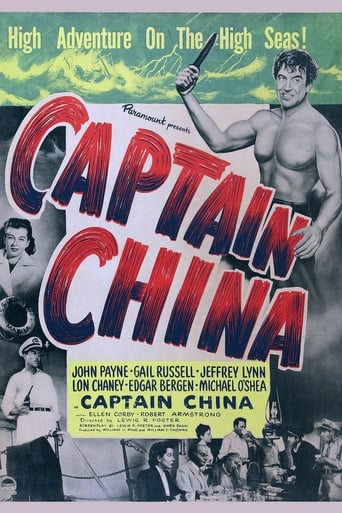Hitting the screen with the force of a raging typhoon!
The title character, played by John Payne, is a ship's captain whose embittered behavior after losing his lady love seemingly leads to tragedy. Accused of deliberately scuttling his ship during a typhoon, Captain China hopes to clear himself by signing on as a common seaman on a vessel captain by his former first mate Brendensen. There's no love lost between the two men, and their mutual animosity is intensified when both fall in love with beautiful passenger.
"Captain China," a 1950 film produced by Pine-Thomas Productions in the United States, is a captivating maritime adventure that blends elements of romance, drama, and suspense. Directed by Lewis R. Foster, the movie stars John Payne as the titular character, a rugged and charismatic ship captain navigating the treacherous waters of the South China Sea. The film's plot revolves around Captain China's efforts to transport a valuable cargo while dealing with a motley crew, dangerous pirates, and his own complicated past. Set against the backdrop of post-World War II Asia, the film offers a glimpse into the challenges and uncertainties of the era. The narrative of "Captain China" is enriched by the compelling performances of its cast, including Gail Russell as the enigmatic passenger Kim Mitchell, who adds a layer of intrigue and romance to the story. Russell's character, a woman with a mysterious background, becomes entangled in the captain's life, leading to a series of dramatic and emotional developments. The chemistry between Payne and Russell is palpable, driving the film's romantic subplot and adding depth to the overall storyline. Supporting actors such as Jeffrey Lynn and Lon Chaney Jr. further enhance the film's dynamic, bringing their unique talents to the screen and contributing to the film's engaging atmosphere. Visually, "Captain China" is notable for its effective use of black-and-white cinematography, which captures the moody and atmospheric essence of the maritime setting. The film's director of photography, Ray Rennahan, skillfully employs shadows and contrasts to heighten the tension and drama of key scenes, particularly during the thrilling pirate attacks and stormy sea sequences. The production design and set pieces also play a crucial role in immersing the audience in the world of the film, with detailed ship interiors and exotic port locations adding authenticity and visual interest. "Captain China" may not be widely recognized today, but it remains a noteworthy example of Pine-Thomas Productions' ability to create engaging and entertaining films on a modest budget. The film's blend of adventure, romance, and suspense, combined with strong performances and atmospheric cinematography, make it a memorable entry in the genre of maritime dramas. For fans of classic cinema and those interested in the cinematic portrayal of post-war Asia, "Captain China" offers a compelling and enjoyable viewing experience.
Año1950
Duración97 minuto
GénerosAcciónAventuraRomance
Países de producciónUnited States of America
